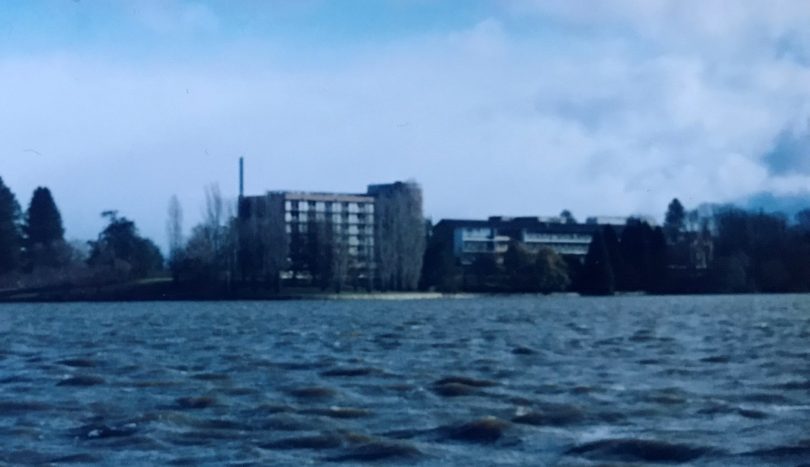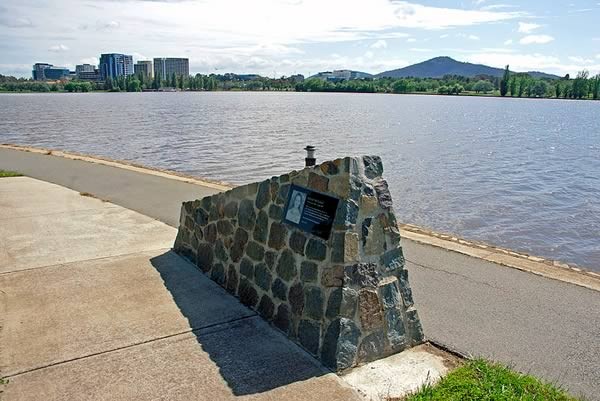
The empty shell of Royal Canberra Hospital at dusk, just two days before the tragic failed implosion in July 1997. Photo: Gavin Dennett.
Yesterday marked 25 years since the tragedy of the failed Royal Canberra Hospital implosion, one of the darkest days in the ACT’s history.
On 13 July 1997, the former hospital at Acton Peninsula was demolished to make way for the National Museum of Australia. The lead-up to the event was celebrated by the Canberra community, with the ACT Government promoting it as a public spectacle and encouraging everyone to attend to watch the bricks and mortar pulverised into dust.
A local radio station held a competition to push the plunger to bring down the building by implosion. The carnival atmosphere at Lake Burley Griffin foreshore on the sunny winter’s day belied the catastrophe that would unfold.
Instead of bringing down the former hospital onto itself, the incorrectly placed explosive devices – undertaken by a company that was hopelessly lacking in technical expertise – detonated outwards, sending metal projectiles towards the lake, the crowd and beyond.
Tragically, 12-year-old Katie Bender, who was in attendance with her family, was fatally struck in the head and killed instantly. Nine other people were injured and many reported frightening near-misses.
I was among the crowd of more than 100,000 people who lined Lake Burley Griffin foreshore that day. Like many Canberrans of our generation, both my sister, Julie, and I were born at Royal Canberra Hospital, so we took a keen interest in the farewell spectacle.
Since being born there in the mid-1970s, I was fortunate to have had few reasons to return. My only other experience at the hospital was in February 1991 when I was taken to emergency after suffering an anaphylactic reaction to peanuts. The facility closed just nine months later, in November 1991.

The view of the empty Royal Canberra Hospital from across Lake Burley Griffin two days before it was demolished by implosion in 1997. Photo: Gavin Dennett.
In 1994, I had a mate who, for a short while, rented a room at Sylvia Hurley House, the dilapidated former nurses’ quarters that stood adjacent to the hospital and was demolished at the same time. I visited him one chilly evening and the creaking, virtually abandoned dormitory building with long empty hallways was eerily quiet and downright spooky.
My only other experience on the peninsula was just two days before the implosion when I drove there to view the empty hospital shell as it awaited its demise. I snapped some photos in the fading light with my cheap, wind-up camera that turned out pretty poor but show the gutted building with a banner attached for Controlled Blasting Services, the Gold Coast-based company responsible for the failed implosion.
By the time Julie and I arrived at Lake Burley Griffin on 13 July 1997, the crowd was already bustling. We found a spot at Lennox Gardens, west of Commonwealth Avenue, and hovered there for a while.
The implosion was still an hour away so we ended up moving further south along the foreshore until we settled on a spot slightly further from the hospital but offering a better view.
From there, we waited while the sense of anticipation grew, thanks largely to the onsite radio broadcast that added to the convivial atmosphere. Then when showtime arrived, the countdown was on, followed by the pushing of the plunger, detonation and three plumes of smoke … and the hospital was still standing.
This should have been a warning that all was not well.
After the initial anticlimactic blast, the puzzled crowd waited before further explosions saw the building come down. However, metal shards and other debris rained down into the lake that was packed with spectator boats and kayaks.
We witnessed the occupants of one kayak overturn it to escape the deadly projectiles.
While that seemed unexpected, and we generally thought the experience hadn’t exactly gone to plan, we weren’t prepared for what came next.

The Katie Bender Memorial at the site where the 12-year-old was killed during the failed implosion of Royal Canberra Hospital. Photo: File.
On our way back to the car, we walked past the site where we had originally perched. It was where Katie Bender had been standing with her family – 430 metres from the blast – when she was hit by metal shrapnel travelling at 130 metres per second.
There was chaos as police marshalled the crowd away from the area and cordoned it off with barricades.
We soon learnt of the tragedy that had unfolded and were shaken by our close call and fateful decision to relocate.
Sadly for Katie, her family and those around her who witnessed her horrifyingly shocking death, they were not so fortunate. Given there were nine other people injured and many reports of lucky escapes, it’s a miracle the number of fatalities wasn’t higher.
Considering metal projectiles ripped through trees, cars and were found as far away as the Treasury building, 1 km away – having sailed over four lanes of gridlocked traffic to get there – it defies belief the safety exclusion zone around the hospital was a paltry 20 metres.
What happened to Katie could have happened to anyone.
My one-in-100,000 experience of the day was by no means unique, but reflecting on the Sliding Doors moment that saw us positioned away from where disaster struck, remains a sobering thought nearly a quarter of a century later.












